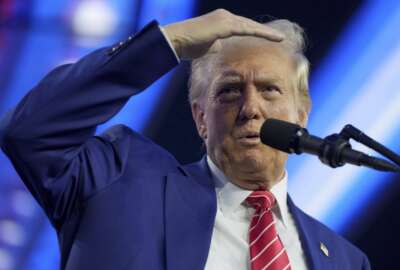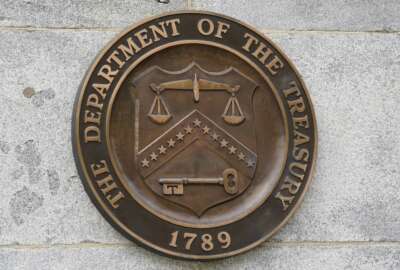How the government ought to about critical minerals security
"The lithium, the cobalt, the nickel. Those we need for electric vehicles and clean energy technologies," said Gracelin Baskaran.
One thing Republicans and Democrats agree on is the need to have secure, domestic supplies of critical minerals. It’s both an economic and national security imperative. So what can the government do to boost reliable domestic supplies? My next guest has studies this question. She’s director of the critical materials security program at the Center for Strategic and International Studies. Gracelin Baskaran joined the Federal Drive with Tom Temin.
Interview transcript:
Tom Temin And I guess everybody talks about Lithium for batteries, but there’s also Cobalt and so forth. Let’s begin, what are the minerals that are so crucial that we have trouble with supplying right now besides lithium and cobalt?
Gracelin Baskaran Yes, there’s kind of three buckets of minerals that we’re worried about. One, they’re the ones you mentioned, the lithium, the cobalt, the nickel. Those we need for electric vehicles and clean energy technologies. The other two buckets of minerals are the ones that have come into sharper focus. So one are the minerals we need for semiconductors. Chips go into every device that we power on, and a lot of the export restrictions coming from China are for the minerals that we need for semiconductors like germanium and gallium. And then we have the third bucket of minerals that we need, which are the things that we need to build our defense technologies. And China recently rolled out new export restrictions and they target something called super hard materials. And super hard materials are what you need for your missiles, satellites, warships, fighter jet. And those minerals are coming under further restriction. So earlier this year, China restricted antimony and we’re now looking at a potential wave of restrictions for commodities like tungsten on the horizon. So these are kind of the three waves of minerals in terms of end use that we’re looking at.
Tom Temin Good thing we don’t have incandescent light bulbs anymore because those used to use tungsten for the filament. But that’s beside the point. Do these things exist in the United States and we just don’t have the wherewithal or the were too afraid of mining to get them? Or do we have to find another country that’s got them?
Gracelin Baskaran That’s a great question. So it’s really divided. I remember sitting next to a wonderful Republican senator at dinner one day and he said, I don’t understand why we don’t just mine what we have here first. With all due respect, Senator, we have about a half of a battery. Because we don’t have everything here. Some of it is the geology God put under our feet. Now, there are commodities that we have here at home, like antimony, which China restricted, which we need for defense, where we had an antimony mine here. But over time, a lot of these mines either stopped mining, they were closed, or maybe the mine didn’t even open in the first place. The United States has the second longest permitting time in the world. It takes 29 years on average to get a mine up and running. And then there are the minerals that we don’t necessarily have, and we need to work with our allies. So it depends on what mineral we’re really looking at.
Tom Temin So a lot of these then that are not in the United States, assuming we could get around the mining issue, they might be in places that are problematic like Africa. Fair to say?
Gracelin Baskaran Absolutely. So you need, for example, gallium, which you need for Chips, comes from bauxite. And one of the biggest bauxite producers in the world is Guinea. It’s the second biggest bauxite producer. Guinea is a very socially and economically fragile African nation that it is a little bit difficult to do business in. So that is a good example of we don’t really produce any gallium domestically in the U.S. and where a lot of that bauxite sit and some of them are challenging jurisdictions.
Tom Temin Maybe you know the answer just as an aside. Canada used to be a major aluminum producer. And if I’m not wrong, aluminum starts with bauxite. Where did Canada get that for all the big aluminum smelters they used to have?
Gracelin Baskaran So Canada has a lot of bauxite. So primarily, and this is it’s really interesting. We have a deeply integrated supply chain for commodities like aluminum, where different parts of the supply chain move back and forth. So the new kind of are we going to have tariffs with Canada could be hugely consequential for aluminum or for nickel, because we, for example, have one nickel mine in America. All of it goes to refining in Siberia, in Canada, and it comes back for manufacturing. So if you thought about putting tariffs on every layer of some of these minerals supply chain, it would be so expensive for end users like you and me to buy these items.
Tom Temin And you can’t make stainless steel without nickel, correct?
Gracelin Baskaran Correct.
Tom Temin All right. Well, then what is your best advice for the new administration coming in? The Biden administration has studied it, and there’s been a few grants out here and there for commercial development of low concentration or dirt where these minerals are. But it’s hard to get it into a refine it into a usable quantity. There are some grants out from that from here and there, but nothing comprehensive.
Gracelin Baskaran So America’s comparative advantage is not necessarily that mining like legislation is easy to do business, but we do have fantastic research and development capabilities. We’ve got big brains here. We have research institutions like School of Mines and M.I.T. and Caltech that are really leading the way with things like how can we substitute minerals. Because we have things at home that we can actually substitute for things that might be in harder jurisdictions for recycling. Right now, we estimate that we can meet about 20% of our future demand through recycling, but I can now get about 98% of my lithium out of a lithium ion battery back out. I couldn’t do that 5 or 10 years ago. And to the end, again, like you said, kind of getting things out of like taking low grade deposits and maximizing our potential. So one would be to continue investing in America’s R&D. That’s going to be really important. The second thing is we do need to advance our domestic mining, because we do have a good resources here. And that’s going to require reducing. Some mines can take up to 30 permits in 29 years. There’s a lot of room to reduce the duplication of those permit and simplify and fast track these processes. And then the final thing I would say is we need to think a little bit more strategically about our engagement internationally. We’re really good at talking, we’re really good at showing up in the right places to have a conversation. But things like financing, even Canada, like we engage a lot with Canada and they’re like We need capital. America’s got capital that we can deploy to our neighbor. Canada saying, why are you, we have financing instruments for low income countries, but we don’t really have a lot of financing instruments for minerals that are friendly, high income countries that have really good reserves. So better leveraging our relationships with our allies to ensure we are funding nickel development in Canada, because currently a lot of it is still coming from Chinese companies in Indonesia.
Tom Temin We’re speaking with Gracelin Baskaran. She’s director of the Critical Materials Security Program at the Center for Strategic and International Studies. And I guess Southeast Asia is another area where some of these things are found. And everywhere you go, China, I guess they call it their Belt and Road project. They don’t just make nice to countries. They build airports and roads and things and kind of defy those companies, if you will, and get access to minerals that way. So it sounds like State Department, USAID, maybe even and a lot of agencies that don’t come to mind immediately, besides Commerce or Energy needs to be brought to bear on this.
Gracelin Baskaran Absolutely. It’s going to be an inter-government interagency effort. We’ve calculated that there’s about 15 government departments working on minerals, but often in a not a very coordinated way through strengthening our coordination. Department of Interior, who identifies which minerals are critical. They have the U.S. Geological Survey. How can we better leverage our geological survey to map areas globally that haven’t been mapped to make it more or reduce the risk associated with private investment, for example? So it’s Department of Defense, these are the minerals we need for defense applications are a lot of them in countries where we need to better leverage state right through minerals like diplomacy. So it’s really an interagency effort that we’re looking at in the next four years.
Tom Temin And this idea of 30 years or so to get a permit for a mine. No company in its right mind would launch a project that it’s going to take 30 years to get permitted. It’s hard enough to build bridges and so forth. Takes four or five or six years. But what’s your recommendation for somehow getting time out of that whole business of mining permits in a nation that’s starting to believe less and less in industry than ever before?
Gracelin Baskaran Great question. One of the lines in my career, there are a few lines I’ve heard that have stuck with me. And you have dinner with the mining executive for a big major mining company. It’s easier for me to mine in Mali and Pakistan than it is in the United States. And I kind of sat back and I was like, Wow, that’s pretty telling. A lot of it is going to be streamlining the many processes and permits. There’s a mining law from 1852 that needs to be reformed, for example. So some of this is addressing these legislative requirements that are sometimes overlapping to streamline it. One of the big things I personally advocate for is a Bureau of Mines. So in 1910, we actually opened a Bureau of Mines in the government to coordinate all of our mining efforts. And if you look at America in 1940, I was reading this letter the president wrote to Congress where he said, We need to build our critical material supply. After the establishment of the Stockpile Act of 1939, because he said we’re going into war and we don’t have the minerals that we need. So a lot of mineral legislation was like 1939 to 1945. We kind of kept working at building mining efforts. We were a top uranium producer at one point for nuclear power. And then in 1996, we actually closed our Bureau of Mine. And then in the 28 years since then, we have not reopened any centralized bureau to coordinate our mining efforts. And that’s really put us on the back foot, because you know having 15 chefs in the kitchen without a coordinating function really hinders our own efforts.
Tom Temin And just a question about mining itself. People see pictures of, say, copper mines and they look like miniature grand canyons, these gigantic things. If you’re mining for antimony or tungsten or something like that. Is the scouring of the earth or the environmental impact manageable nowadays so that you don’t have to have a giant hole filled with horrible chemicals that EPA will have to take care of in 20 years?
Gracelin Baskaran It’s more manageable than ever before. It’s a requirement now generally, globally, for mines to submit a closure plan before they even open the mine. And the closure plan actually details how you’re going to address a lot of those environmental externalities. The reality is mining is still not a sexy field. It is either a deep hole underground or it is an open pit at the ground. It is one of the reasons we really struggle to attract talent. Nobody grows up and thinks I want to be a miner. But the mining industry of today is very different. It’s not the wheelbarrow and the ax. It’s AI it’s machine learning. I can sit miles away and do my blasting. So it is a very different industry and it is less harmful than it was before. And industry is really committed to continuing that trajectory to minimize externality. But it’s not a pretty industry at the end of the day, I would say.
Tom Temin So then besides drill, baby, drill, maybe the administration should say dig, baby, dig.
Gracelin Baskaran The digging. It’s the drilling. It’s the machine learning. I personally think we should throw AI in there. It might sound a little bit cooler than digging or drilling.
Tom Temin But you still need a big yellow machine with teeth on it to carve away.
Gracelin Baskaran You do. And what’s so cool if you go to a mine is sometimes they don’t even have drivers. Like the mining industry has been pushing driverless efforts for a really long time because it makes it safer. You think about mining and how many people over have died. The less people I involve, the better. So like, it’s amazing how few people you actually need to run a mine now. You need like highly skilled engineers who can do it from afar as opposed to people actually on a mine digging.
Copyright © 2025 Federal News Network. All rights reserved. This website is not intended for users located within the European Economic Area.
Tom Temin is host of the Federal Drive and has been providing insight on federal technology and management issues for more than 30 years.
Follow @tteminWFED






